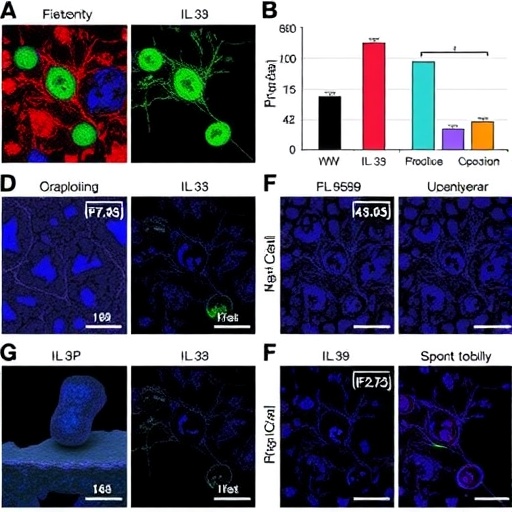
Decoding the Immune Landscape: Understanding Innate Lymphoid Cells in Asthma
Asthma, a chronic respiratory condition affecting millions worldwide, is often tied to complex immune system responses. Recent insights delve into distinct immune cell types, particularly innate lymphoid cells (ILCs) and innate-like lymphocytes, which are revealing hidden pathways that could lead to innovative therapies. In their groundbreaking study, Thio et al. present a comprehensive dissection of these cells, illuminating their roles in asthma’s pathology and suggesting novel therapeutic avenues that can be explored.
At its core, asthma is characterized by bronchial hyperreactivity and inflammation. Recent advances in immunology have shed light on the roles played by ILCs, a diverse family of immune cells that function as rapid responders to environmental cues. Unlike T cells, which require specific antigen recognition, ILCs are equipped to respond instantly to inflammatory signals. This unique capacity makes them key players in both the onset and the progression of asthma, tying the condition to broader immunological phenomena and uncovering potential intervention points.
Among the important subsets of ILCs, ILC2s have drawn particular attention. These cells respond to allergens and helminth infections by producing cytokines like IL-4, IL-5, and IL-13. Their role in orchestrating type 2 immune responses places them at the forefront of asthma-related inflammation. This paper punctuates the need for a deeper understanding of ILC2 function and regulation, as their dysregulation has been implicated in various allergic diseases.
The paper also emphasizes the contribution of innate-like lymphocytes, such as regulatory T cells and natural killer T cells, which possess characteristics of both innate and adaptive immunity. These cells are positioned at the nexus of immune activation and regulation, highlighting their dual role in fostering immune responses while maintaining homeostasis. The authors suggest that tracing the interactions between these cells and conventional lymphocytes could unveil new therapeutic strategies aimed at rebalancing immune responses in asthmatics.
Moreover, Thio et al. discuss the potential effects of environmental factors and cytokine signaling in shaping the ILC landscape. Asthma exacerbations can be triggered by environmental stimuli—such as pollutants, allergens, and respiratory infections—interacting with these immune cells. Understanding how these environmental cues influence ILC function and differentiation could guide interventions aimed at ameliorating asthma symptoms.
In exploring potential therapeutic implications, Thio et al. do not shy away from the challenges faced in targeting ILCs. While manipulating these cells holds promise for treatment, potential off-target effects can exacerbate existing conditions or lead to unforeseen complications. Therefore, precision medicine strategies that tailor therapies to individual patients’ immune cell profiles could pave the way forward.
The authors also outline a vision for the development of novel biological therapies targeting specific cytokines involved in ILC function. By either neutralizing or mimicking specific cytokines, researchers may create highly specific treatments that can modulate the immune response without compromising the overall immune system integrity. This approach could empower a new generation of asthma therapies.
Notably, Thio et al.’s research aligns with an emerging trend in asthma therapeutics focused on molecular targeting. As genome sequencing and biotechnological innovations continue to evolve, the realization of personalized medicine in asthma management becomes more tangible. By integrating genetic data with environmental exposures, the long-term goal is to craft individualized treatment plans that effectively curb asthma’s severity and frequency.
Furthermore, the international collaboration highlighted in this study underscores the collective effort required to unpack the intricacies of asthma and its related immune pathways. Multidisciplinary teams are essential for translating laboratory discoveries into clinical practices, ensuring that findings lead to actionable insights for patients suffering from the condition.
As we reflect on the insights provided by Thio et al., it’s evident that the journey to unravel the complexities of asthma is far from over. The ongoing research into ILCs and innate-like lymphocytes will require continued attention and resources. Still, the potential for groundbreaking discoveries and transformative therapies shines brightly on the horizon.
In sum, this research opens up new avenues for exploring how the immune system contributes to asthma pathology. By focusing on the intricacies of immune cell behavior, we can hope for a future where asthma therapies are not merely symptomatic treatments but instead address the very core of immune dysfunction.
As the scientific community harnesses this promising knowledge, the potential to reshape asthma treatment modalities rests on understanding and modifying the very cells that orchestrate immune responses in this disease. This redefined focus could ultimately usher in a new era for asthma management, with strategies that are as innovative as they are precise, ensuring that patients can breathe a little easier.
Subject of Research: The role of innate lymphoid cells and innate-like lymphocytes in asthma.
Article Title: Decoding innate lymphoid cells and innate-like lymphocytes in asthma: pathways to mechanisms and therapies.
Article References: Thio, C.LP., Shao, JS., Luo, CH. et al. Decoding innate lymphoid cells and innate-like lymphocytes in asthma: pathways to mechanisms and therapies. J Biomed Sci 32, 48 (2025). https://doi.org/10.1186/s12929-025-01142-w
Image Credits: AI Generated
DOI: https://doi.org/10.1186/s12929-025-01142-w
Keywords: Innate lymphoid cells, asthma, immune response, cytokines, therapy, precision medicine.
Tags: asthma inflammation pathwaysbronchial hyperreactivity mechanismscytokines in asthma managementenvironmental triggers of asthmaILC2s in allergic reactionsILCs in respiratory conditionsimmunology advancements in asthmainnate immune cells in asthmainnovative asthma therapiesrole of innate lymphoid cellstherapeutic approaches for asthmatype 2 immune response in asthma




